AMD Radeon RX 7900 XT: Two minute review
Listen, we really hope you're going to read the full review below, but we're going to make a big sweeping statement right now that might render all our hard work worthless: this GPU didn't really need to exist.
Does that mean it's a bad GPU? Absolutely not! The AMD Radeon RX 7900 XT is a very solid choice of graphics card, offering amazing gaming performance at a very competitive price point. Broadly speaking, it hits all the same high notes (and has all the same foibles) as the excellent flagship RX 7900 XTX - but that's sort of the problem.
Let's take a quick departure from AMD to look at Nvidia's newest GPUs. The RTX 4090 is crazily expensive but provides a monstrous amount of power for that price; conversely, the RTX 4080 costs $400 less at MSRP in the US, and is significantly less powerful as a result.
With this in mind, the price disparity between the two new Radeon cards - a mere $100 - feels strange. As you'll see further down, the performance difference does mostly align with the gap in pricing, with the more powerful XTX card proving to be slightly better value for money overall. If you've got the cash to drop on a $899 GPU, you can realistically afford a $999 GPU, surely? Why wouldn't you wait a little longer to scrape together that extra hundred bucks, and buy the superior product?
Therein lies the problem: while AMD has skilfully undercut Nvidia when it comes to the price-to-performance ratio of its new cards, Team Red is falling back into its old ways and repeating the same mistakes of the RX 6000 generation by already overcrowding the price bands of its GPUs.
The previous generation had a 'too many cooks' problem, where lots of closely-priced variants (like non-XT and xx50 models) caused consumer confusion. We're concerned that we might be witnessing the beginning of a similar mess.
Despite this, we can't really mark down the Radeon RX 7900 XT itself; the card performs admirably for its $899 price tag, with massive improvements over RDNA 2 when it comes to ray tracing and FSR performance. If you're looking for one of the best graphics cards for gaming on a 4K monitor, this is a sound pick - and it's damn good value for money, too.
Most of the criticisms we can level at the RX 7900 XT line up with our issues with the XTX version of the GPU: it lags behind Nvidia in creative workloads and uses rather a lot of power during general use (though still nothing compared to the mighty RTX 4090 at full load), and while ray-traced performance has improved significantly it's still not up at Nvidia's level.
Nonetheless, this GPU and its big sibling both demonstrate the huge potential of AMD's new RDNA 3 architecture, and we can't wait to see what AMD does next. If you need a new graphics card for your gaming PC and haven't been able to buy one - either due to scalping or crypto-mining bots hoovering up as many GPUs as possible - then the Radeon RX 7900 XT is definitely worth a look.
AMD Radeon RX 7900 XT: Price & availability

- How much is it? $899 / £799 / around AU$1,345
- When is it out? December 13, 2022
- Where can you get it? Available in the US, UK, and Australia
The launch MSRP of the AMD Radeon RX 790 XT is $899 in the US, putting it an even hundred dollars below the flagship RX 7900 XTX. UK pricing starts at £799, with Australia expected to pay somewhere in the region of AU$1,345.
It's worth noting that these prices are only for the reference card produced by AMD itself, and the majority of RX 7900 XT cards on the market will be made by manufacturing partners such as Sapphire, Gigabyte, and XFX. These cards are likely to have their own individual retail prices which may be a bit more expensive than the original MSRP.
The card launched on December 13, 2022, which means you can buy one right now - assuming you can find one. Stock availability was predictably spotty during the initial launch, with scalped cards showing up on eBay and Newegg with horribly inflated price tags. Thankfully it seems that the $999 XTX card has borne the brunt of this, with XT stock still available from some retailers at the time of writing.
In any case, the $899 price tag is indicative of AMD's desire to be as competitive as possible against Nvidia - a situation mirrored by the similarly aggressive pricing of the XTX card. Earlier this year, the previous-gen RX 6900 XT got a massive price drop from $999 to $679, further showcasing AMD's goal of providing seriously competitive prices for its gaming GPUs.
Considering that the RX 7900 XT comes in at $300 cheaper than the RTX 4080, Nvidia is getting absolutely destroyed when it comes to bang for your buck. That's a 25% lower price tag, but as you'll see in our benchmark results later in this review, the RX 7900 XT only performed 15% worse than the 4080 on average. We're thoroughly expecting Nvidia to respond with a price cut in the near future, although we doubt Team Green will admit the reason behind such a move.
Sadly, we won't be adding either of these cards to our best cheap graphics card ranking, though we sorely hope that both AMD and Nvidia give us some budget GPUs in the not-too-distant future. $899 is still a lot to spend on a single PC component, leaving this GPU out of reach for many gamers.
- Value: 4 / 5
AMD Radeon RX 7900 XT: Features & chipset

- New chiplet design hailing from Ryzen CPUs
- Generational improvements for ray tracing and upscaling tech
- 20GB of VRAM and DisplayPort 2.1 improves 4K and 8K output
GPU: Navi 31
Stream Processors: 5,376
AI Accelerators: 168
Ray Accelerators: 84
Power draw (TGP): 315W
Base clock: 1,900MHz
Boost clock: 2,400MHz
VRAM: 20GB GDDR6
Bandwith: 800GB/s
Bus interface: PCIe 4.0 x16
Outputs: 1 x HDMI 2.1a, 2 x DisplayPort 2.1, 1 x USB Type-C
Power connector: 2 x 8-pin
The AMD Radeon RX 7900 XT uses a cut-down version of the same Navi 31 GPU found in the flagship XTX card, and this change is largely reflected in the pricing, so top marks for AMD there.
The exciting thing about this is the new chiplet design being employed for the RDNA 3 GPU die - or more accurately, dies plural, since the chiplet design employs multiple dies with ultra-fast interconnects. The main 5nm node from TSMC is linked with additional 6nm dies for cache memory, a design choice that presumably enabled AMD to keep the production costs low, since the older 6nm nodes are cheaper to produce.
This chiplet architecture was originally seen in AMD's own Ryzen and EPYC processors, and proved very successful in that arena. It's not hard to understand why Team Red opted to pursue the same technology in its GPU design too.
In the same vein, both the XT and XTX cards use cheaper GDDR6 memory rather than the GDDR6X VRAM found in Nvidia's new RTX GPUs. The memory chiplets - plus additional cache memory - allows AMD to effectively skip over Nvidia and achieve more memory bandwidth for less money, another clear win.
In total, there's 20GB of GDDR6 VRAM to play with here, 4GB less than the XTX model but still plenty for whatever you want to throw at this card. Combined with the new DisplayPort 2.1 video output, 4K and 8K are viable (though don't expect to be playing the latest triple-A games at 8K!)
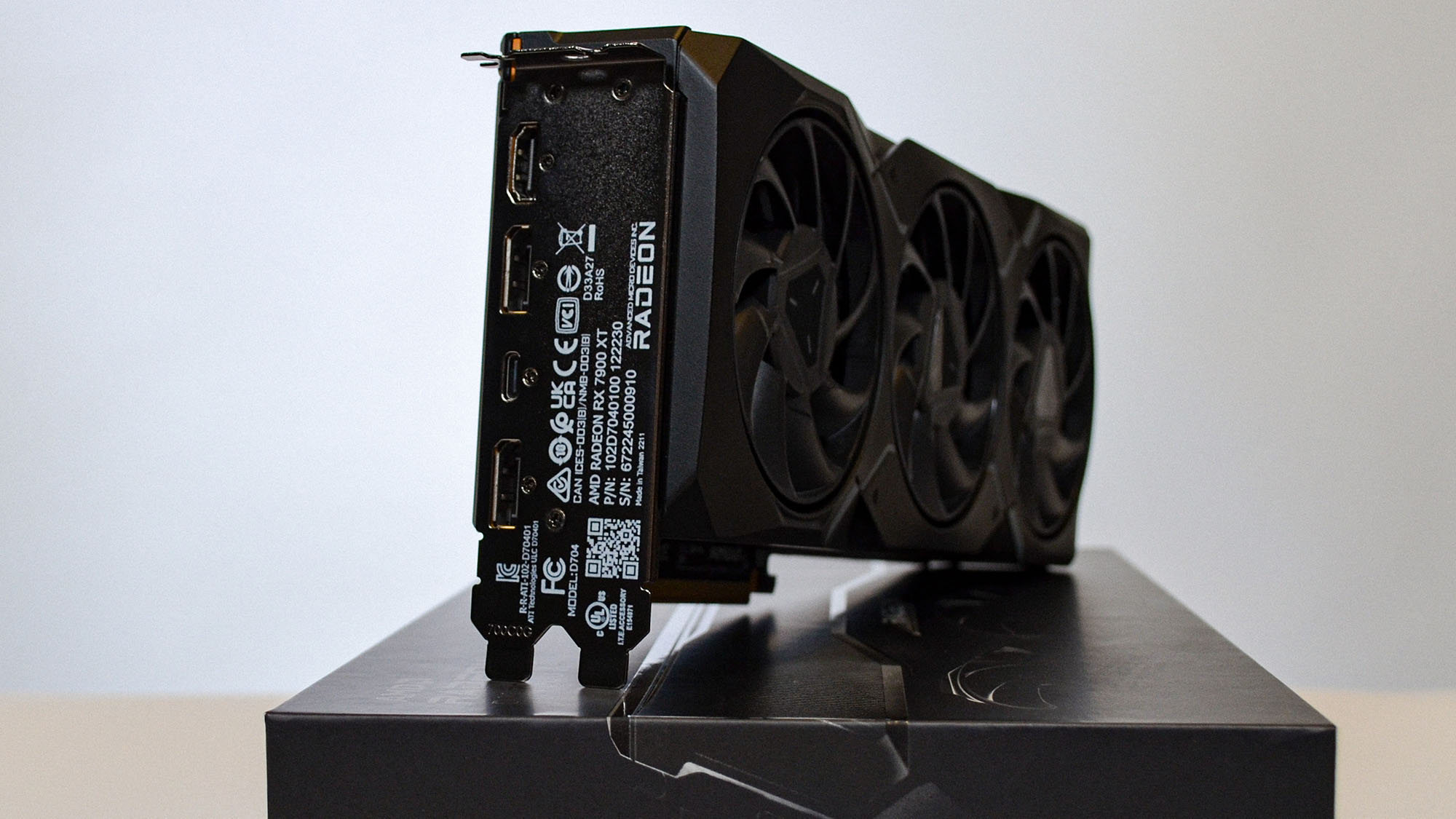
Unfortunately, AMD is still lagging behind Nvidia's GPU market domination in other areas, even if some serious generational improvements have been made here. The second-gen Ray Accelerators found in the RX 7900 XT are a big step up from AMD's first-gen attempt, but they don't compete with the ray-tracing capabilities of the RTX 4000 cards (although it's worth noting that they do beat Nvidia's own second-gen ray-tracing cores as seen in the RTX 3090).
We've also got new 'AI Accelerator' cores, which are roughly comparable to Nvidia's Tensor Cores in that they handle AI-related tasks such as deep learning. Nvidia is currently on fourth-gen Tensor Cores, so AMD definitely has some catching up to do when it comes to the AI capabilities of its GPUs.
Lastly, even though the FidelityFX Super Resolution (FSR) upscaling tech has made some significant process in enabling ray-traced 4K gameplay on AMD GPUs, Nvidia's new DLSS 3 completely eclipses it thanks to full frame generation (rather than the pixel generation used by DLSS 2 and the current FSR 2.0). We do know that the currently-in-development FSR 3.0 will feature frame generation too, though, and FSR 2.0 can now be used in a much wider range of games.
- Features & Chipset: 4 / 5
AMD Radeon RX 7900 XT: Design

- Uses two 8-pin connectors rather than a single 16-pin port
- Relatively compact for a high-end GPU
- Three different types of video output
Thankfully, AMD hasn't followed suit after Nvidia and made its new GPUs stupidly big. The Radeon RX 7900 XT is a lot smaller than the competing RTX 4080, measuring 287mm in length with a conventional two-slot design.
It's a card that should fit comfortably in most standard ATX-scale PC cases, and hopefully third-party models from other manufacturers will stick to this sizing. It's comparable to any of Nvidia's RTX 3000 cards in size, which feels like a breath of fresh air compared to the comically huge RTX 4090.
It's also just a generally good-looking GPU, with a straightforward reference design that looks much better than previous designs from AMD, which we felt looked blocky and old-fashioned.

Beyond mere matters of aesthetics, the RX 7900 XT is equipped with a robust cooling solution that includes three fans and a solid metal shroud covering the heatsink. There's a small amount of lighting, but it's mostly quite a reserved design, which we like. There's room at the far end of the card for a GPU support bracket to be attached.
A key difference between this card and Nvidia's new GPUs is the power connector found on the top of the card. Unlike the 16-pin connector seen on the RTX 4090 - which has caused a bunch of rather burning issues for Nvidia - AMD has opted for a straightforward pair of 8-pin PCIe connectors with no need for any sort of adaptor if you're using an older PSU.
Since the RX 7900 XT draws just over 300W of power at full load, the 2x8-pin connector should be more than sufficient here. Interestingly, the RTX 4080 can use a total of three 8-pin connectors (which fit via an adaptor into the single 16-pin connector on the card) for almost the exact same amount of power, which arguably proves that Nvidia didn't need to mess about with those dodgy 16-pin connectors at all.
Beyond the power connectors, the other ports on offer here are a good selection. We've got two of the aforementioned DisplayPort 2.1 ports, a standard HDMI output, and a USB-C video out port. The latter is the most interesting inclusion here, since it allows the support of a wider variety of monitors - including all the best USB-C monitors.
- Design: 5 / 5
AMD Radeon RX 7900 XT: Performance

- Generally great gaming performance
- Improved ray-tracing over the previous gen
- Blender performance really drags down the average
This is the system we used to test the AMD Radeon RX 7900 XT:
CPU: AMD Ryzen 7 5800X3D
CPU Cooler: Corsair iCue H150i Elite Capellix 360mm AIO
RAM: 64GB Corsair Dominator LED DDR4-3200
Motherboard: Gigabyte Aorus Master X570 (BIOS F36c)
SSD: Samsung 980 Pro 1TB NVMe M.2 SSD
Power Supply: Corsair AX1000
Case: Praxis Wetbench
Let's face it: we can bang on about the features and physical design of the card all day, but none of that will matter if the performance doesn't measure up. Fortunately, the Radeon RX 7900 XT performs well in most areas - with a few small failings here and there.
In terms of value for money, it's excellent. General gaming performance at 4K is good - all of our gaming test results below are raw results that don't use AMD FSR 2.0 for boosting framerates, so bear that in mind - and many synthetic benchmarks returned strong results.
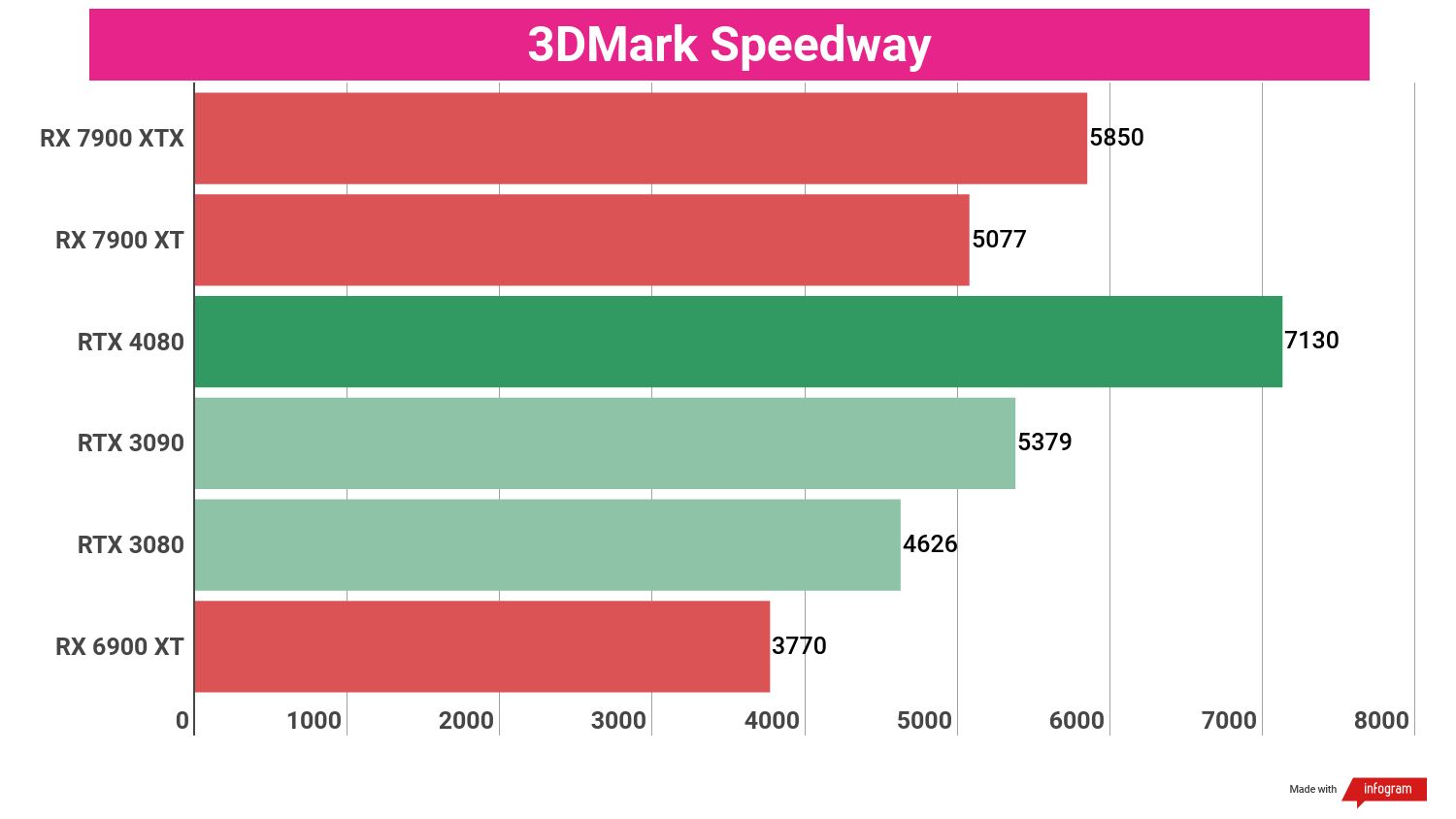
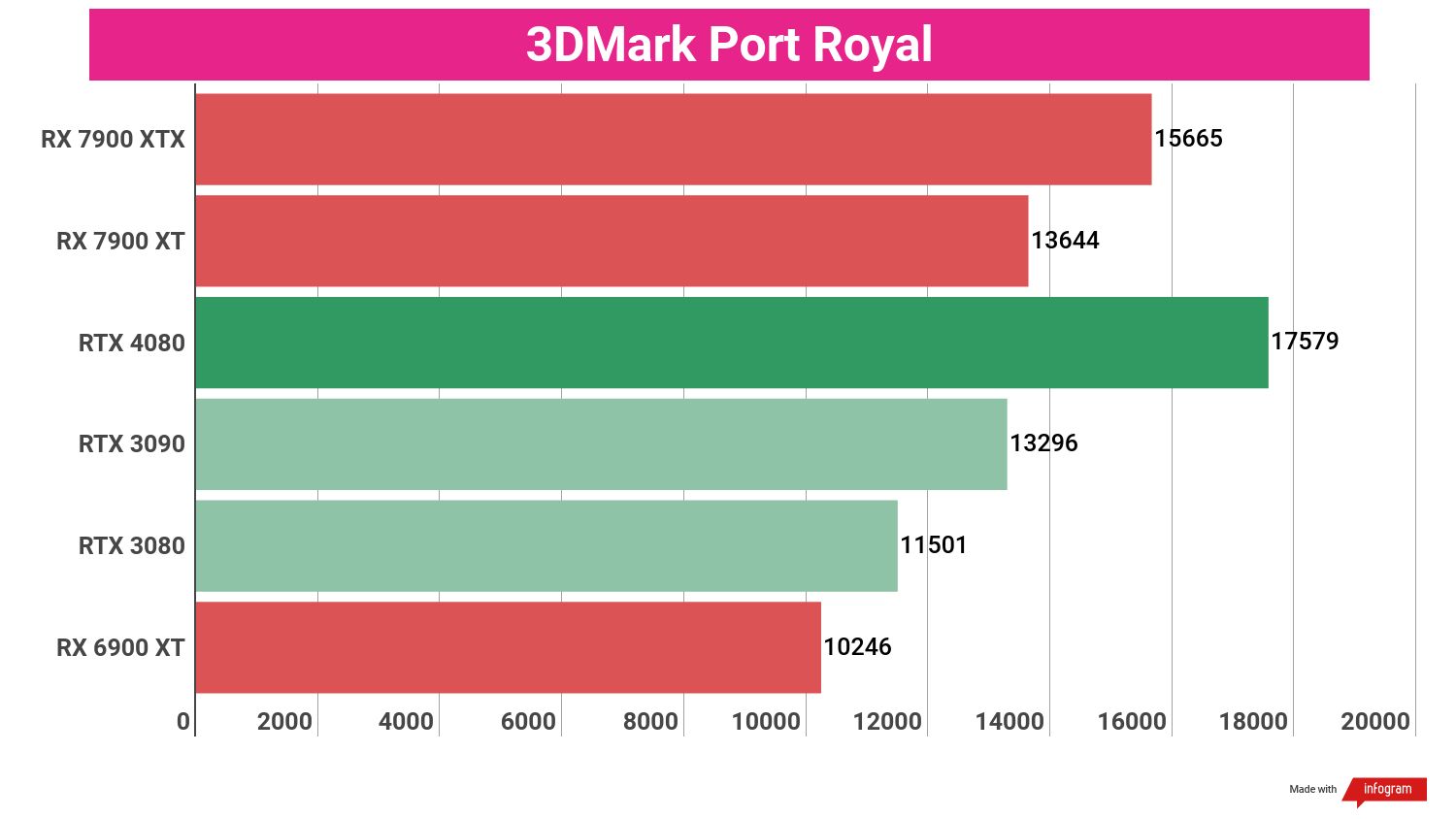




Unsurprisingly, synthetic tests such as 3DMark's suite of benchmarks showed performance slightly below the RX 7900 XTX and the RTX 4080, with the exception of ray-traced tests such as Port Royal, where the AMD cards were roundly outperformed by Nvidia.
In many tests, the RTX 4080 sits between the two new Radeon GPUs. Averaging all our synthetic tests put the RX 7900 XT at about 10% slower than the 4080 - a very impressive showing given the 25% price difference.
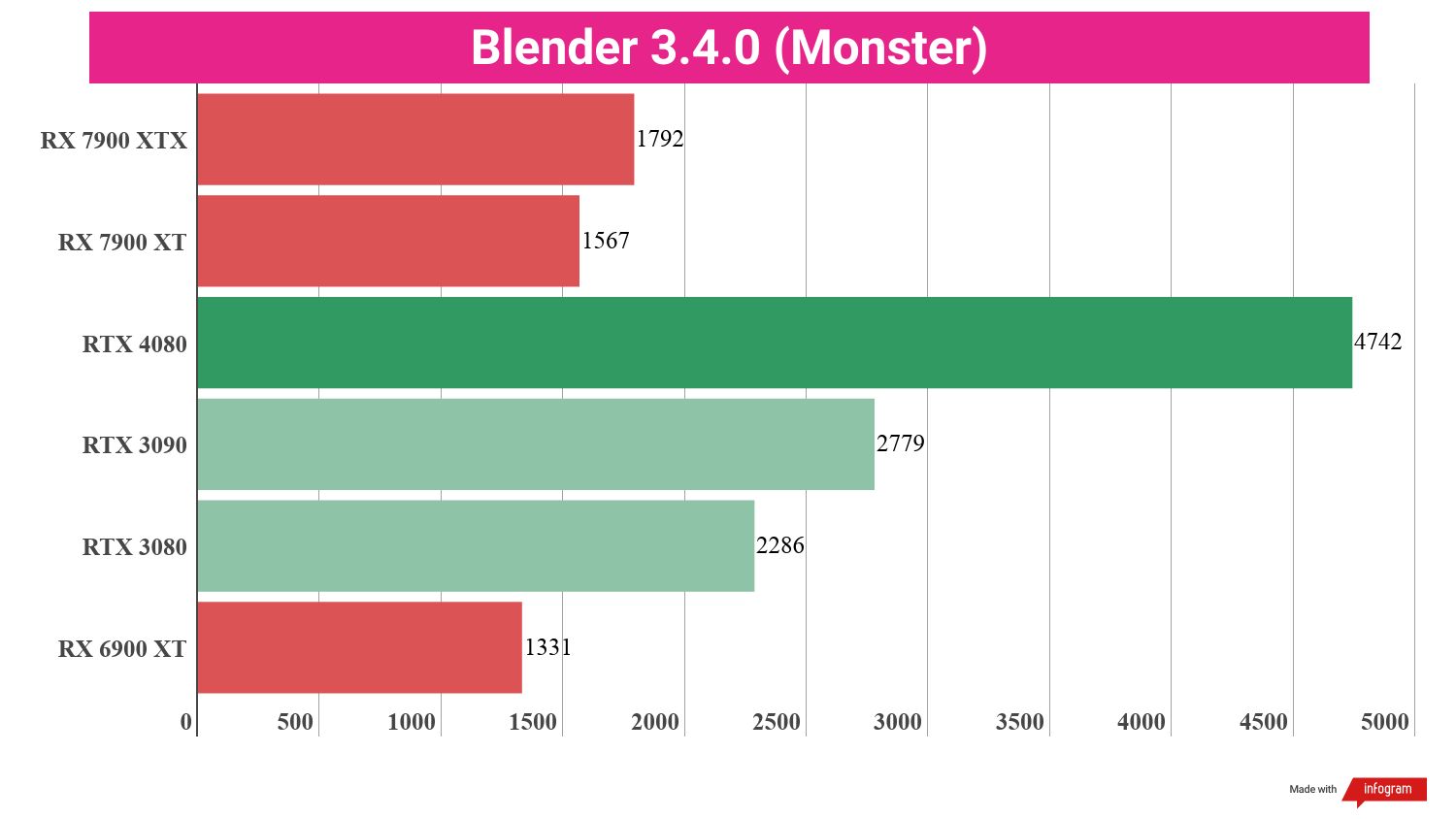


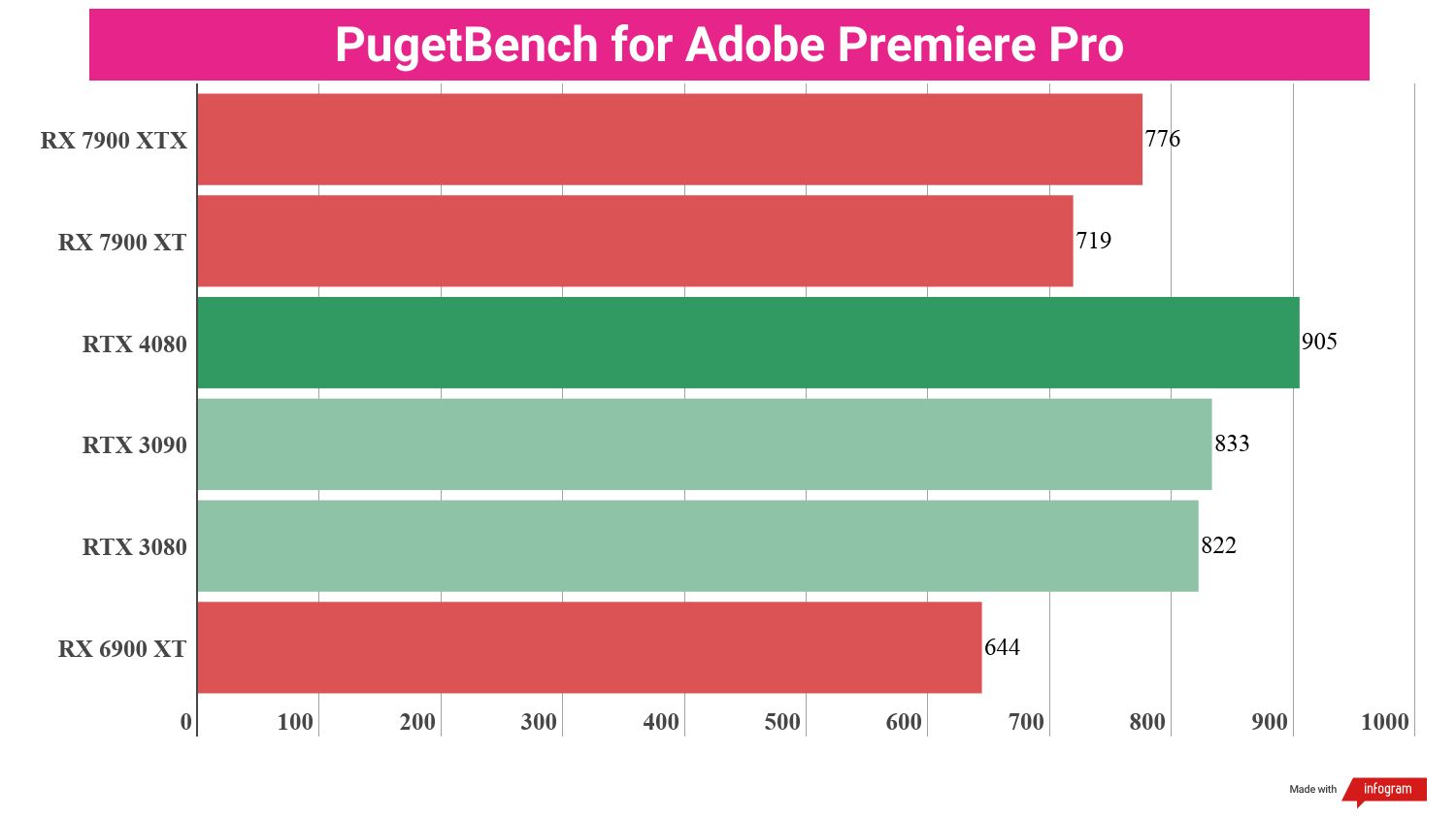


The biggest weakness of AMD's new RDNA 3 GPUs is indisputably the creative performance. In particular, Blender tests were very behind Nvidia's scores, although Blender is known to be better optimized to run on Nvidia's CUDA cores. On average the RX 7900 XT gave less than half the performance of the RTX 4080 in creative benchmarks - however, removing Blender from the average brings it back to a 10% difference, marking that as an outlier.
AMD is apparently hoping to improve Blender performance via the use of a rewritten open-source programming language that takes better advantage of the existing hardware, changes that should arrive in Blender 3.50 and beyond.
Until those updates land, though, anyone who is planning on using Blender (especially professional creatives) should really stick with Nvidia. It's worth noting that the RTX 4090 is still the best possible pick for these types of workloads - if you need a powerful GPU for working in Blender, don't settle for the 4080.

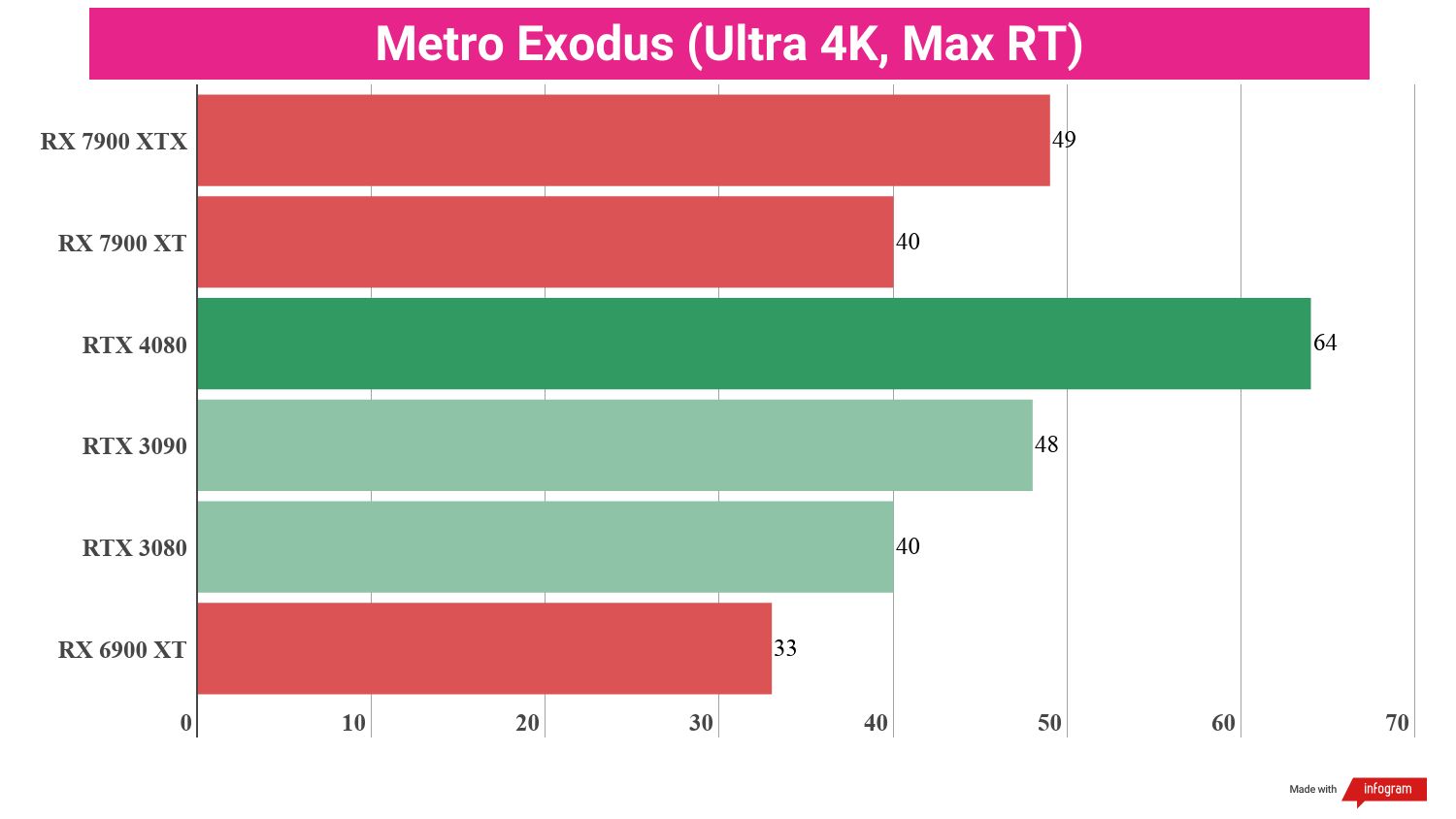
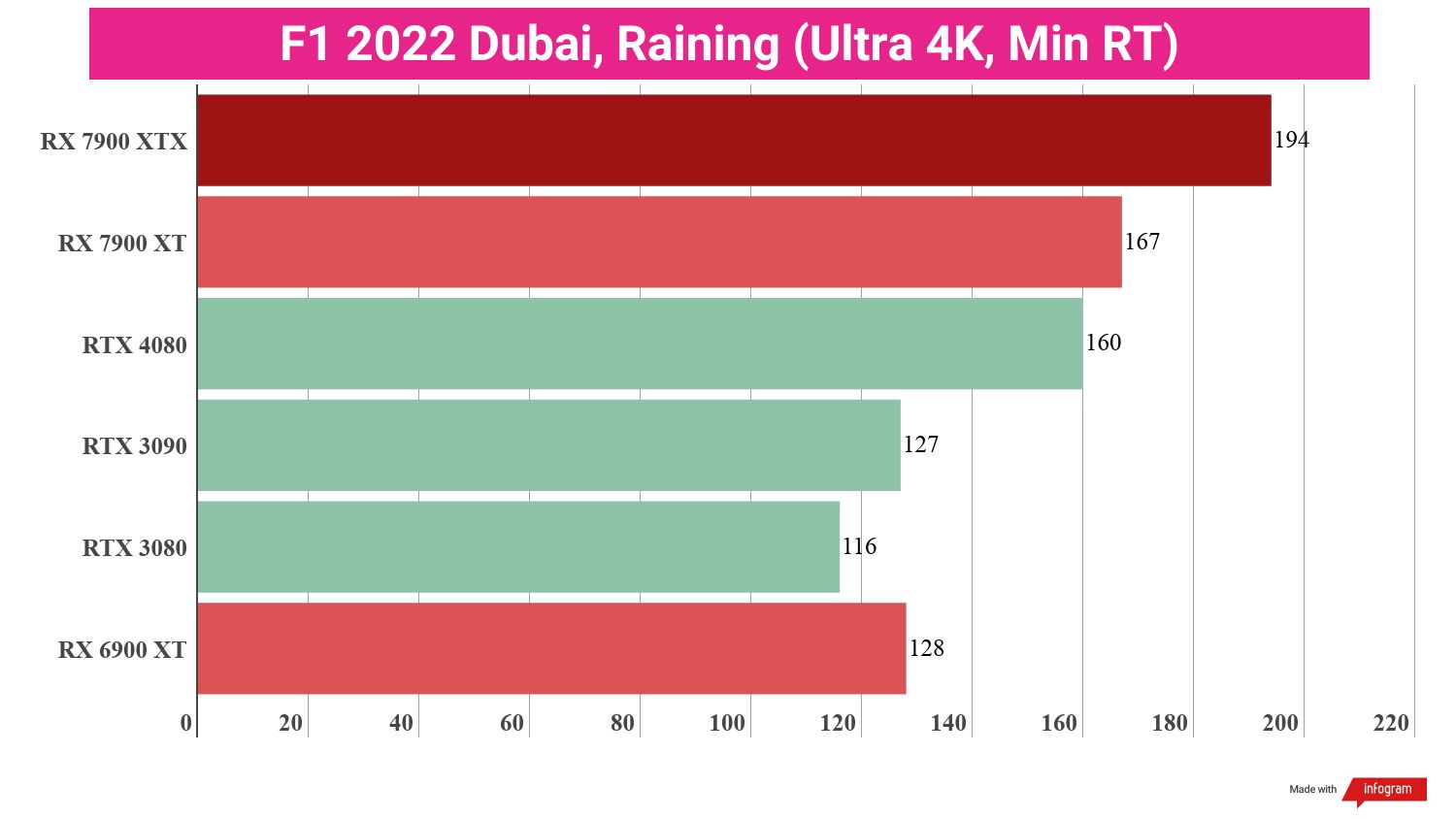




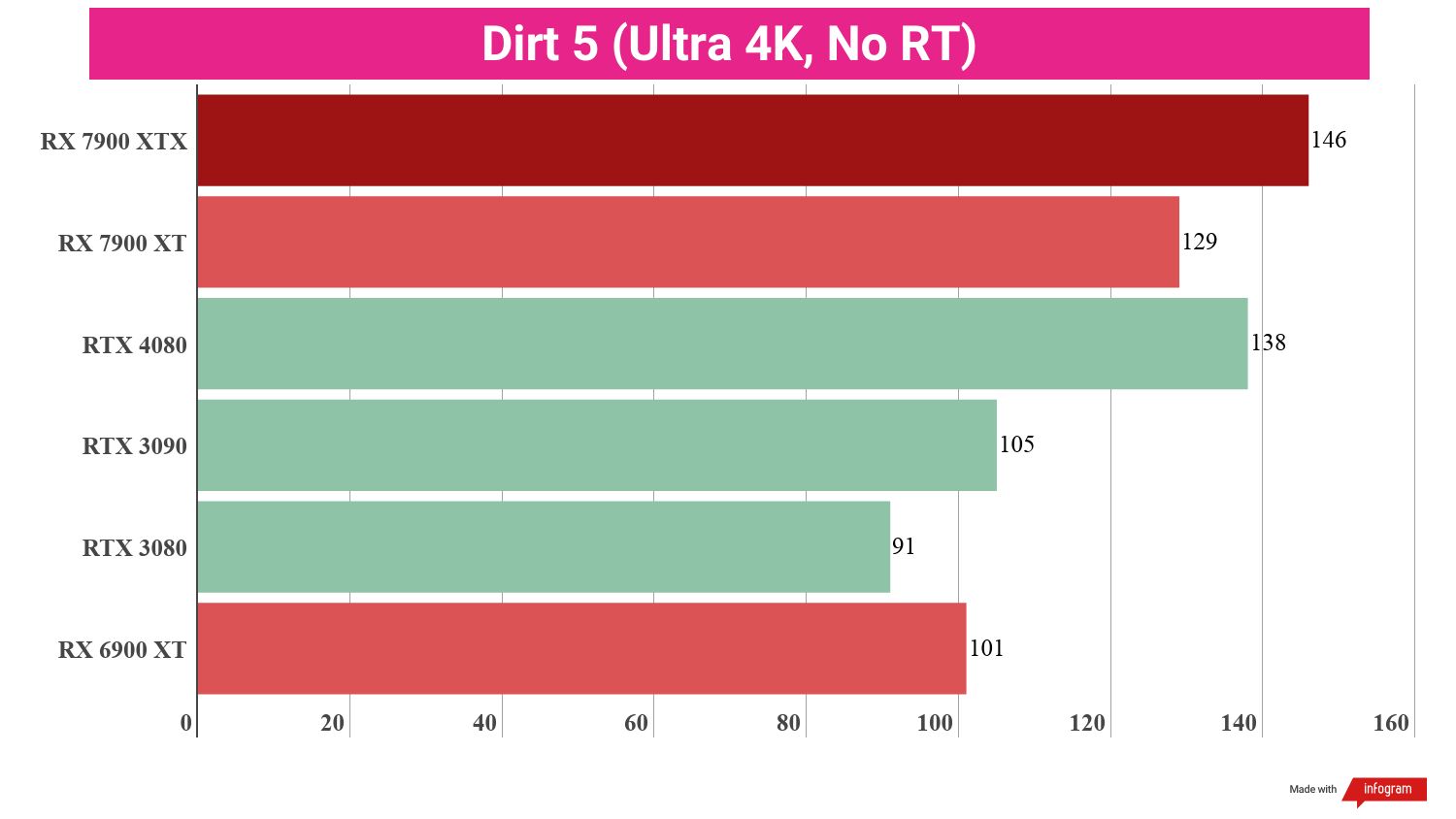







AMD has made it clear that it wants to be the 'gamers choice' of hardware, so let's dig into the gaming performance on offer here.
Broadly speaking, synthetic test results line up with real-world gaming benchmarks. The RX 7900 XT does struggle significantly with ray-traced workloads, but actually manages to beat the much more expensive RTX 4080 in F1 2022 and almost match it in Hitman 3 - oddly, both of these benchmarks are set in Dubai in-game. What's that all about?
Looking at a complete aggregate of gaming performance, the average framerate across all our game tests was 76fps - compared to 88fps for the RX 7900 XTX and 87fps for the RTX 4080.
That's a decent showing against the competing Nvidia card, but doesn't stack up super well against the XTX: it's 10% cheaper than the flagship Radeon card, but gaming performance is 13.6% worse. Since AMD is trying to make gaming the focus, it's a shame to see the XT model lag behind a bit - it's hard to recommend this GPU when the XTX simply offers better gaming performance for the price.
Unlike the XTX, it's not quite as effective when it comes to 4K Ultra gaming as a result. It can clear 60fps in the majority of games without ray tracing turned on, but it's not quite as comfortable in its performance levels as the XTX. If you're willing to drop the settings ever so slightly you'll be able to hit high framerates, though.
It's also worth reiterating that this was without FSR 2.0 turned on. You'll see from our scores that the RX 7900 XT didn't score well in Cyberpunk 2077, but turning on FSR 2.0 provided a huge boost with and without ray tracing enabled. It's a massive difference, almost doubling the real-world framerate in supporting games.
It's not going to be as effective as DLSS 3 on the new Nvidia GPUs, but it's seriously impressive when using the 'Quality' preset. Once FSR 3.0 lands, we could see an even bigger shift.





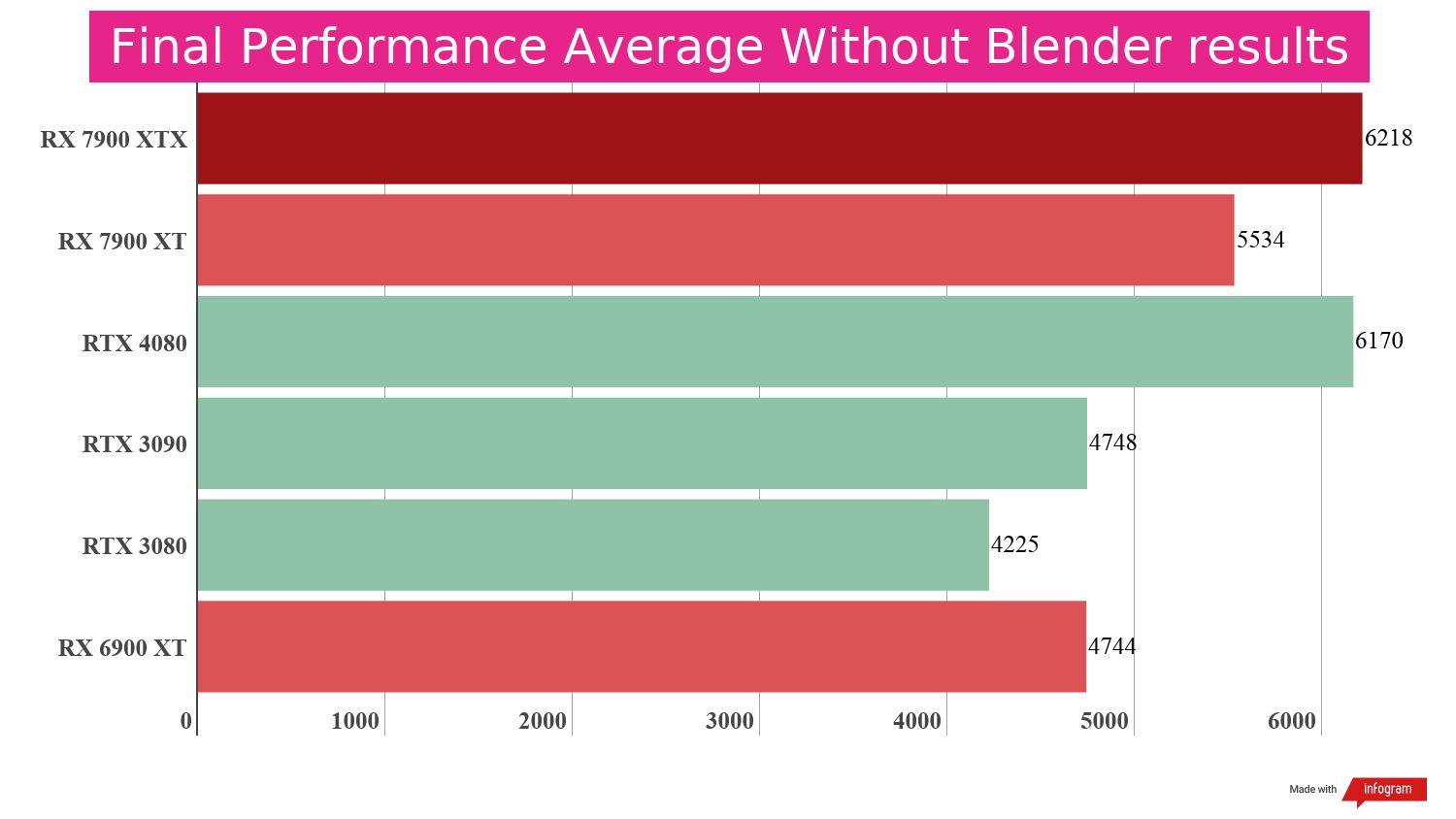




These games do look great - with FSR 2.0 turned on, you can get some silky-smooth performance at 4K. Meanwhile, anyone playing at 1440p or 1080p is going to achieve some ludicrous framerates; don't buy this GPU if you're only going to play Valorant and Overwatch, basically, unless you have some sort of fetish for triple-digit framerates. Consider the refresh rate of your screen if you're going to buy this card; if you've got a 1440p monitor with a 144Hz refresh rate, you're going to max it out and might actually want to upgrade your display too.
It's also worth noting that while ray-traced performance falls far behind Nvidia's cards, not many games actually feature ray tracing. It's still a niche feature that the vast majority of gamers just don't care about, so we can't really mark the RX 7900 XT down too heavily for that. DLSS 3 also isn't supported by that many games at this stage, so it's a minor advantage for Nvidia in practical terms.
When it comes to thermal performance and power efficiency, the new Radeon cards lose out to Nvidia pretty badly. While the RX 7900 XT has very similar power draw and heat output at maximum load compared to the RTX 4080, our recorded minimums were massively above those of Nvidia's competing card. This means that while the TDP of the AMD GPU is actually lower than that of the 4080, it'll burn through more electricity on average.
Breaking things down to a final performance average, though, the RX 7900 XT is good if not incredible compared to the other next-gen cards on the market right now. If you've got a $900 hard limit, this is a great choice of GPU. If you can afford a little more, though, we still think its XTX comrade is the rightful owner of the best AMD graphics card crown.
- Performance: 4 / 5
Should you buy an AMD Radeon RX 7900 XT?

Buy the AMD Radeon RX 7900 XT if…
Don’t buy the AMD Radeon RX 7900 XT if…
Also consider
AMD Radeon RX 7900 XT Report Card
First reviewed in December 2022
via Tech Trade
Comments
Post a Comment